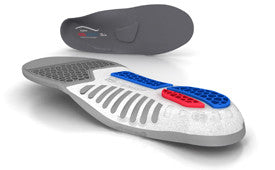
Relieve Plantar Fasciitis: Stretching Secrets
Research has shown tight calf muscles and a tight plantar fascia may be responsible in whole or in part for plantar fasciitis. As part of a comprehensive treatment program, stretching exercises are essential for relieving arch and heel pain in both the athletic and general populations. Follow these instructions to help relieve the symptoms of plantar fasciitis:
1. No barefoot walking—Not one step!
2. Wear a supportive shoe with a 2.5cm (1-in.) heel height to relax the calf muscles.
3. Wear an orthotic insole in your shoe all day—A Spenco® Total Support® Insole would be a good choice if you have pronated feet (foot tends to roll inward), and a Spenco® Polysorb® Walker/Runner is a good insole for a high arch or supinated foot type (foot tends to roll outward).
4. To reduce the severe morning pain, step straight out of bed into a heeled house shoe or slipper, or a running shoe with your insoles inside—Do not walk to the bathroom barefoot!
5. Avoid activities you know worsen the pain—stair climbing: take the elevator for now. Avoid standing on tiptoes: use a footstool instead. You may need to change your exercise program to allow the pain to settle.
6. If the pain is severe, see your doctor to get anti-inflammatory or analgesic medication.
7. Complete the following stretching exercise program every day until the pain subsides: 
Fig. 1
Instructions:
• Take up the position shown in Fig. 1A.
• Make sure both feet are turned in slightly, i.e., “pigeon toed”.
• Keep the back knee straight and bend the front knee as you lean towards the wall to deliver a stretch to the large calf muscle called Gastrocnemius as shown in Fig. 1B.
• Hold the stretch for 30 seconds.
• Do not over-stretch. You should feel a gentle pulling sensation in the calf or the plantar fascia—with no pain.
• Then, without changing position, bend the back leg and drop the hips as shown in Fig. 1C to create a stretch in the Soleus muscle lower down in the calf.
• Again, hold the stretch for 30 seconds—and remember no pain!
• Complete at least 10 holds of each stretch every morning and evening.
To consolidate and prolong the effect of your morning stretching program, perform “under the desk” calf muscle stretching throughout the day. If done repeatedly, this stretch will eventually become a habit.

Fig. 2 Under the Desk Calf Muscle Stretch
Instructions:
• Sit close to the edge of your chair so you can straighten your leg and rest the heel on the ground under the desk but remain close enough to work Fig. 2.
• With the knee kept straight, pull your foot upwards (dorsiflexion) to place a gentle stretch on the calf muscle.
• Hold each stretch for 30 seconds. Remember, no pain in the calf or fascia!
• Complete 20 holds for 30 seconds.
• Try to get in a set of 20 stretches every two hours.

Fig. 3 Plantar Fascia Stretching
Instructions:
• Sit with your foot on your lap.
• Pull upwards on the toes to stretch the plantar fascia Fig. 3.
• Feel a stretch but no pain.
• Hold the stretch for 30 seconds.
• Try to get in at least three sets of 20 holds for 30 seconds every day until the symptoms subside.
• Stop this stretch if the pain seems to worsen, and then begin again once soreness has settled down.
Bad Stretching: Avoid These Exercises
Certain calf muscle and plantar fascia stretching exercises may worsen plantar fasciitis. Avoid the “negative heel” and “toes against the wall’ exercises that may place too much tensile stress and strain through the fascia and increase the pain Fig. 4.

Fig. 4 Stretches to Avoid! "Negative Heel" and "Toes Against the Wall"
Should your symptoms continue to worsen despite the advice provided, see your doctor or other registered health care specialist without delay.
Leave a comment
Comments will be approved before showing up.
Also in Foot Health News

